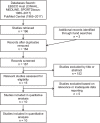Changes in Dorsiflexion and Dynamic Postural Control After Mobilizations in Individuals With Chronic Ankle Instability: A Systematic Review and Meta-Analysis
- PMID: 30870009
- PMCID: PMC6522095
- DOI: 10.4085/1062-6050-380-17
Changes in Dorsiflexion and Dynamic Postural Control After Mobilizations in Individuals With Chronic Ankle Instability: A Systematic Review and Meta-Analysis
Abstract
Objective: To conduct a systematic review with meta-analysis assessing the effectiveness of joint mobilizations for improving dorsiflexion range of motion (DFROM) and dynamic postural control in individuals with chronic ankle instability.
Data sources: Electronic databases (PubMed, MEDLINE, CINAHL, and SPORTDiscus) were searched from inception to January 2017.
Study selection: Included studies examined the isolated effects of joint mobilizations to enhance DFROM and dynamic postural control in individuals with chronic ankle instability and provided adequate data to calculate effect sizes (ESs) and 95% confidence intervals (CIs).
Data extraction: Two investigators independently assessed the methodologic quality, level of evidence, and strength of recommendation using the Physiotherapy Evidence Database scale and the Strength of Recommendation Taxonomy. We extracted the sample sizes, means, and standard deviations for DFROM and dynamic postural control and filtered the data based on control-to-intervention and preintervention-to-postintervention (pre-post) comparisons.
Data synthesis: We included 7 level 1 and 3 level 2 studies that had a median Physiotherapy Evidence Database score of 60% (range = 40%-80%). The magnitudes of control-to-intervention and pre-post differences were examined using bias-corrected Hedges g ESs. Random-effects meta-analyses were conducted for each outcome measure and comparison. Positive ESs indicated better outcome scores in the intervention group than in the control group and at postintervention than at preintervention. The α level was set at .05. Meta-analysis revealed weak and moderate ESs for overall control-to-intervention (ES = 0.41; 95% CI = 0.14, 0.68; P = .003) and pre-post (ES = 0.34; 95% CI = 0.20, 0.48; P < .001) DFROM analyses. Overall, dynamic postural control meta-analysis revealed moderate control-to-intervention (ES = 0.42; 95% CI = -0.14, 0.98; P = .14) and weak and moderate ESs for pre-post (ES = 0.37; 95% CI = -0.12, 0.87; P = .14) analyses.
Conclusions: We observed grade A evidence that joint mobilizations can mildly improve DFROM among individuals with chronic ankle instability compared with controls and preintervention. We observed grade B evidence that indicated conflicting effects of joint mobilizations on dynamic postural control compared with controls and preintervention.
Keywords: Maitland mobilization; Mulligan mobilization; Star Excursion Balance Test; weight-bearing lunge test.
Figures





Similar articles
-
Rehabilitation and Improvement of Health-Related Quality-of-Life Detriments in Individuals With Chronic Ankle Instability: A Meta-Analysis.J Athl Train. 2017 Aug;52(8):753-765. doi: 10.4085/1062-6050-52.5.01. Epub 2017 Jul 13. J Athl Train. 2017. PMID: 28704635 Free PMC article.
-
Effects of joint mobilization on chronic ankle instability: a randomized controlled trial.Disabil Rehabil. 2015;37(7):601-10. doi: 10.3109/09638288.2014.935877. Epub 2014 Jul 3. Disabil Rehabil. 2015. PMID: 24989067 Clinical Trial.
-
The immediate effects of an anterior-to-posterior talar mobilization on neural excitability, dorsiflexion range of motion, and dynamic balance in patients with chronic ankle instability.J Sport Rehabil. 2014 Nov;23(4):351-9. doi: 10.1123/jsr.2013-0085. Epub 2014 Apr 3. J Sport Rehabil. 2014. PMID: 24700526 Clinical Trial.
-
Dynamic Balance Measures in Healthy and Chronic Ankle Instability Participants While Wearing Ankle Braces: Systematic Review With Meta-Analysis.J Sport Rehabil. 2020 Oct 12;30(4):660-667. doi: 10.1123/jsr.2020-0224. J Sport Rehabil. 2020. PMID: 33049703
-
The Examination of Repeated Self-Mobilizations With Movement and Joint Mobilizations on Individuals With Chronic Ankle Instability.J Sport Rehabil. 2020 Oct 12;30(3):458-466. doi: 10.1123/jsr.2019-0363. J Sport Rehabil. 2020. PMID: 33049708 Clinical Trial.
Cited by
-
Immediate effect of manual therapy techniques on the limitation of ankle dorsiflexion: a randomized, controlled, blind clinical trial protocol.Trials. 2021 Dec 6;22(1):886. doi: 10.1186/s13063-021-05858-6. Trials. 2021. PMID: 34872614 Free PMC article.
-
Postural analysis of children with muscle retraction after six-month exercise or heel cup interventions in a randomized trial.Sci Rep. 2025 Apr 19;15(1):13578. doi: 10.1038/s41598-025-98527-6. Sci Rep. 2025. PMID: 40253482 Free PMC article. Clinical Trial.
-
Increased Femoral Neck Anteversion is Prevalent in Male Elite Youth Soccer Players with Chronic Ankle Instability.Indian J Orthop. 2024 Aug 25;58(12):1852-1860. doi: 10.1007/s43465-024-01245-w. eCollection 2024 Dec. Indian J Orthop. 2024. PMID: 39664358
-
Effectiveness of balance training in patients with chronic ankle instability: protocol for a systematic review and meta-analysis.BMJ Open. 2021 Sep 21;11(9):e053755. doi: 10.1136/bmjopen-2021-053755. BMJ Open. 2021. PMID: 34548370 Free PMC article.
-
Inferior tibiofibular joint mobilization with movement and taping does not improve chronic ankle dorsiflexion stiffness: a randomized placebo-controlled trial.J Man Manip Ther. 2021 Apr;29(2):73-82. doi: 10.1080/10669817.2020.1805690. Epub 2020 Aug 18. J Man Manip Ther. 2021. PMID: 32808592 Free PMC article. Clinical Trial.
References
-
- Waterman BR, Belmont PJ, Jr, Cameron KL, DeBerardino TM, Owens BD. Epidemiology of ankle sprain at the United States Military Academy. Am J Sports Med. 2010;38(4):797–803. - PubMed
-
- Hintermann B, Boss A, Schäfer D. Arthroscopic findings in patients with chronic ankle instability. Am J Sports Med. 2002;30(3):402–409. - PubMed
-
- van Rijn RM, van Os AG, Bernsen RM, Luijsterburg PA, Koes BW, Bierma-Zeinstra SM. What is the clinical course of acute ankle sprains? A systematic literature review. Am J Med. 2008;121(4):324–331. e6. - PubMed
-
- Tyler TF, McHugh MP, Mirabella MR, Mullaney MJ, Nicholas SJ. Risk factors for noncontact ankle sprains in high school football players: the role of previous ankle sprains and body mass index. Am J Sports Med. 2006;34(3):471–475. - PubMed
Publication types
MeSH terms
LinkOut - more resources
Full Text Sources
Medical

